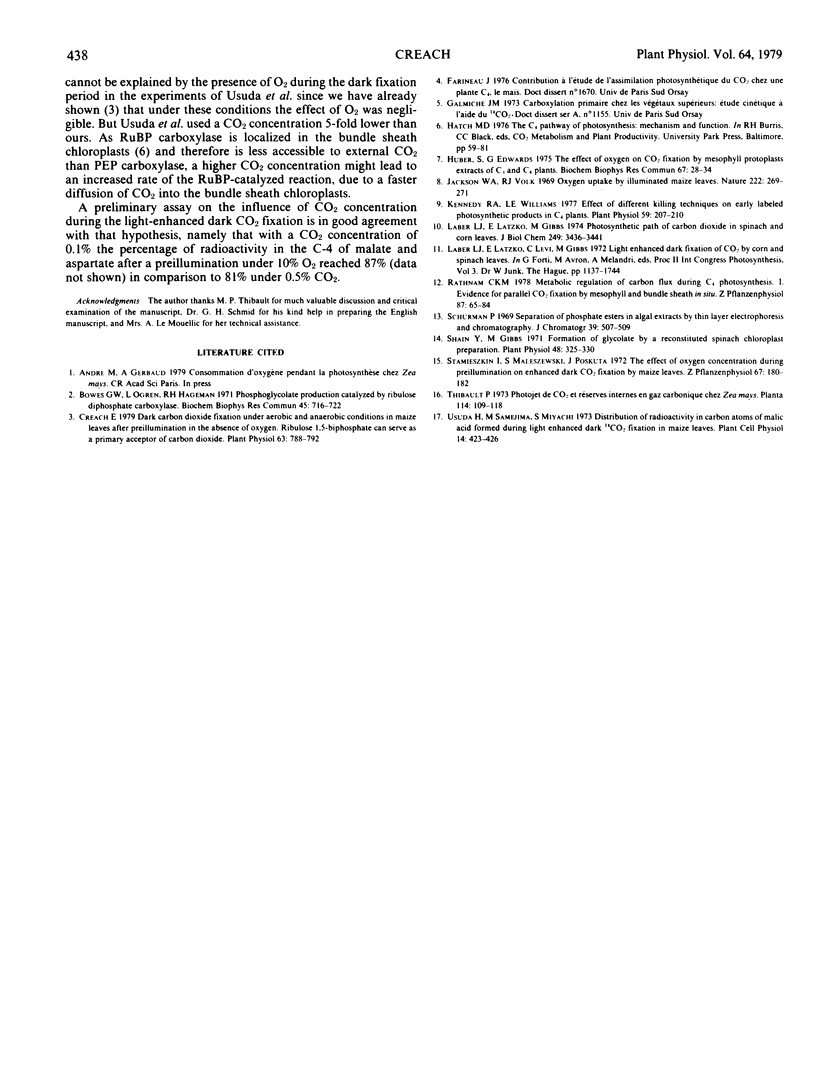Abstract
The enhanced dark CO2 uptake after a preillumination period under varying O2 concentrations has been measured with maize, a C4 plant. For comparison the same study has been conducted with tomato, a C3 plant. Increasing the O2 concentration during preillumination inhibits by 70% the subsequent dark CO2 uptake in tomato but stimulates 2-fold this CO2 uptake in maize. The O2 enhancement of CO2 uptake in maize is due to the enhancement of malate and aspartate synthesis. The percentages of radioactivity incorporated in the C-4 of malate and aspartate vary from 74 to 87% when O2 concentration during preillumination is increased from 0 to 100%.
An interpretation of these data led to the conclusion that malate and aspartate formed during the light-enhanced dark fixation result from two competing carboxylation reactions: a single carboxylation of phosphoenolpyruvate and a double carboxylation involving ribulose 1,5-bisphosphate and phosphoenolpyruvate carboxylases. This latter route of carbon flow prevails when preillumination is carried out anaerobically. It appears that increasing O2 concentration stimulates phosphoenolpyruvate synthesis during preillumination and consequently favors the single carboxylation of phosphoenolpyruvate, leading to an increased percentage of radioactivity in the C-4 atom of malate and aspartate.
Full text
PDF



Selected References
These references are in PubMed. This may not be the complete list of references from this article.
- Bowes G., Ogren W. L., Hageman R. H. Phosphoglycolate production catalyzed by ribulose diphosphate carboxylase. Biochem Biophys Res Commun. 1971 Nov 5;45(3):716–722. doi: 10.1016/0006-291x(71)90475-x. [DOI] [PubMed] [Google Scholar]
- Creach E. Dark Carbon Dioxide Fixation under Aerobic and Anaerobic Conditions in Maize Leaves after Preillumination in the Absence of Oxygen: Ribulose 1,5-Bisphosphate Can Serve as a Primary Acceptor of Carbon Dioxide. Plant Physiol. 1979 Apr;63(4):788–791. doi: 10.1104/pp.63.4.788. [DOI] [PMC free article] [PubMed] [Google Scholar]
- Huber S., Edwards G. The effect of oxygen on CO2 fixation by mesophyll protoplast extracts of C3 and C4 plants. Biochem Biophys Res Commun. 1975 Nov 3;67(1):28–34. doi: 10.1016/0006-291x(75)90278-8. [DOI] [PubMed] [Google Scholar]
- Jackson W. A., Volk R. J. Oxygen uptake by illuminated maize leaves. Nature. 1969 Apr 19;222(5190):269–271. doi: 10.1038/222269a0. [DOI] [PubMed] [Google Scholar]
- Kennedy R. A., Williams L. E. Effect of different killing techniques on early labeled photosynthetic products in c(4) plants. Plant Physiol. 1977 Feb;59(2):207–210. doi: 10.1104/pp.59.2.207. [DOI] [PMC free article] [PubMed] [Google Scholar]
- Laber L. J., Latzko E., Gibbs M. Photosynthetic path of carbon dioxide in spinach and corn leaves. J Biol Chem. 1974 Jun 10;249(11):3436–3441. [PubMed] [Google Scholar]
- Schürmann P. Separation of phosphate esters and algal extracts by thin-layer electrophoresis and chromatography. J Chromatogr. 1969 Feb 25;39(4):507–509. [PubMed] [Google Scholar]
- Shain Y., Gibbs M. Formation of glycolate by a reconstituted spinach chloroplast preparation. Plant Physiol. 1971 Sep;48(3):325–330. doi: 10.1104/pp.48.3.325. [DOI] [PMC free article] [PubMed] [Google Scholar]


